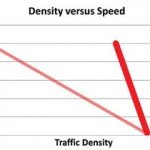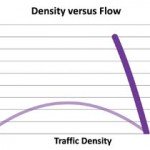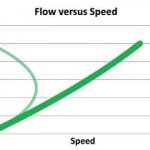Potentially doubling vehicle kilometres travelled
One of the benefits of driverless cars touted is that they could either drop their owner at their workplace then go and park themselves, or could drive home, so as to reduce the space take in city centres devoted to car parking. Whilst reducing land take for parking could be beneficial, such claims ignore one consequence of this: namely that cars would end up driving twice as far a day: as instead of one round trip from home to a city centre car park and then back again, they would now drive from home to the owners’ workplace then back to home and then repeat this journey when it is time to collect the owner.
This would increase pollution (unless all driverless cars were electrically powered and all power generation was from pollution-free, renewable sources). Moreover, it would roughly double traffic levels on city streets, hence likely resulting in increased congestion.
Problems for traffic control systems
In fact, congestion levels could more than double. At present, traffic signals take advantage of what is termed “tidal flow.” Put simply, in the morning peak there is more traffic travelling to the city centre than in the reverse direction; whilst in the evening peak there is usually more traffic flowing out of the city centre.
As such, optimised traffic signals tend to give more green time to those movements with the greatest flows. If driverless cars were to return home after dropping their owner at work and then drive back into the city to collect them, then not only would overall traffic levels increase, but even more critically, traffic flow would no longer have the same level of tidality. Consequently, average delays at junctions would increase for all vehicles. And where city networks are close to capacity (as is often the case) this also raises the danger of traffic queues at intersections blocking back to their other junctions upstream. There becomes a larger danger of gridlock.
Increased Vehicle Circulation
A further problem is likely to arise, whether cars return home during the day or whether they park themselves downtown and then come to collect their owners when their owners wish to return home. Unless and until the forecourts and/ or other vehicular circulation facilities of buildings are overhauled there is unlikely to be sufficient capacity for vehicles to wait to collect their owners. Such remodelling of buildings’ facilities is likely to be quite time-consuming and costly, even where retro-fitting is possible. And more likely, the space requirements for this would likely undo a large proportion of mooted land take savings from reducing down town parking spaces.
Consequently, it is highly likely that vehicles would need to circulate in the vicinity of their owners’ workplaces whilst awaiting their owner’s arrival for collection. Such vehicular circulation would of course further increase traffic congestion levels!
A Possible Paradox of Increased Vehicle Collisions (“Car Crashes”)
Whilst collision avoidance mechanisms built into driverless cars would make them safer, there is also a paradoxical danger of such vehicles increasing overall accident rates on urban road networks.
A human driver would quickly realise that driverless cars are programmed to avoid collisions. As such, a human-controlled vehicle is likely to be able to squeeze computer-controlled cars more effectively than cars driven by other humans, for instance when wishing to change lanes or to turn onto a road. The computer controls in the other car would prioritise collision avoidance and so would cede space to more aggressively (human) driven cars.
The problem is this: a human driver becoming conditioned to being able to squeeze in front of computer controlled vehicles may well assume that a vehicle is computer-controlled, only to discover too late that it was under human control. And the human driving the other car, with slower reaction times than the computer and likely also having a more aggressive mindset than a “robot” car, may well end up in a collision. After all, there could still be someone in the driver’s seat when a car is under computer control, so it would not be readily apparent which cars are being actively driven by their occupant and which are being driven by computer.
Pedestrian safety and a collapse in traffic speeds and road capacities
Another related problem pertains to the interaction between pedestrians and driverless cars. Driverless cars would need to be programmed to avoid collisions with pedestrians, including any who might jump off of the pavement/ sidewalk and into traffic with little or no warning. Consequently, driverless cars will need to respond instantaneously to any such instances of pedestrians stepping into the road.
This raises a number of possible problems. Firstly, pedestrians are likely to quickly realise that driverless cars would allow them to cross the road. Pedestrians are likely to take advantage of this; so urban traffic speeds could collapse as pedestrians make a habit of stepping into traffic more often than they currently do. As such, traffic may become very frequently interrupted, thus resulting in far lower effective capacities on roads.
However, bearing in mind that for some time to come after the introduction of driverless cars, that they would be sharing the road with human-controlled vehicles, there is an increased risk of a human controlled vehicle rear-ending a computer-controlled vehicle which comes to a sudden halt to avoid hitting a pedestrian. On this last point, it might be argued that the human controlled car could have some collision avoidance technologies; however, this presupposes
that all vehicles would quickly switch to such technologies.
It could be argued that the presence of human controlled cars, and the danger of jaywalking pedestrians being sued when a human controlled car rear-ends a driverless car due to the jaywalking pedestrian stepping into the road, would tend to mitigate against such accidents happening. However, in many jurisdictions this could require a change to how insurance liability is apportioned, possibly itself requiring a change in legislation.
Indeed, it has been argued that driverless cars are likely only to widely feature in society, not only after a raft of legislation has been revised, but also following a number of legal test cases.
Cities for Pedestrians or for Cars
There is little doubt that over recent decades the trend in most cities has been to prioritise the motor car, in terms of allocating not only road space, but also parking space; often resulting in pedestrians being forced onto footbridges or underpasses.
However, in some cities, primarily though not exclusively in Europe, a counter-trend is now emerging. Many cities are now looking to increase the pedestrianisation of areas, so as to improve the urban environment. Also in many cities, both in Europe but moreover also in much of the rest of the World, including India, there is an increased emphasis on promoting public transport; this often combined with demand management measures for car usage. Given such trends, one also has to question whether or not cars, even under computer control, would continue to be accepted in great numbers in city centres.
Bear in mind that should a time come when the overwhelmingly majority of cars are fully computer controlled, then so as to avoid issues with pedestrians stepping out into the road at will, there would need to be a massive step-up in legislation and enforcement against jaywalking, even on minor roads. In many cities, this would require a social shift to accept such prohibitions on freedom of pedestrians to cross roads; and in many places such a social shift would be greater than that required to accept driverless cars per se.
Based on the above, I would contend that driverless, or fully computercontrolled cars:
- Are likely to have a substantial role in increasing the safety and capacity of segregated highways, such as expressways and motorways; but,
- Are unlikely to have a substantial and widespread role within city centres (excepting any segregated highways passing through urban areas).
(Richard Di Bona is a Hong Kong-based transport consultant with over 20 years of consultancy experience gained from projects in over 30 countries. He has undertaken a wide range of transport planning, demand forecasting, economic appraisal and transport policy projects).
 TrafficInfraTech Magazine Linking People Places & Progress
TrafficInfraTech Magazine Linking People Places & Progress




